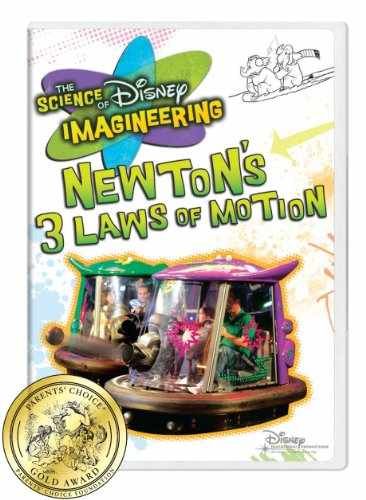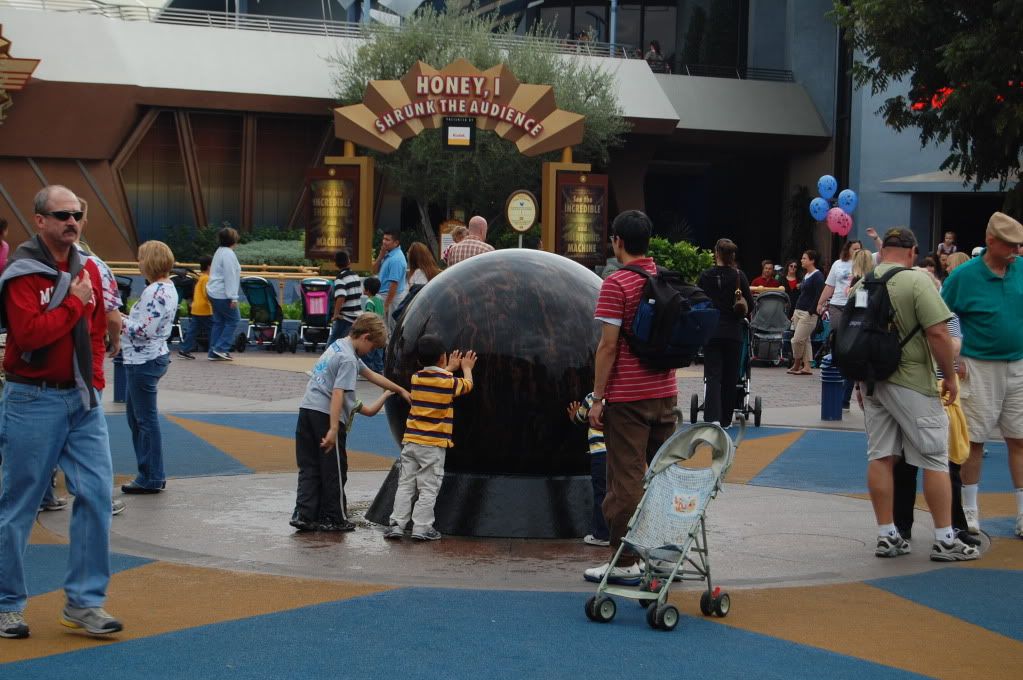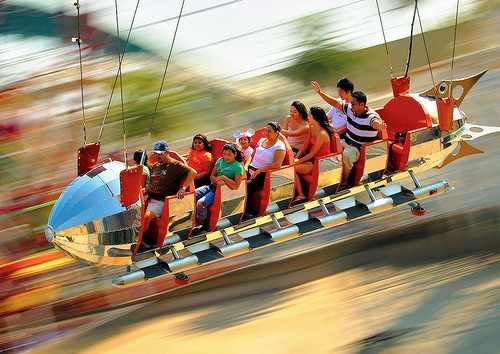
Asa's Invention: There's no invention again. This time Asa starts out in his work area juggling three balls--a recurring theme in the DVD, melons and bowling balls don't work so well although in theory you could juggle these too. We also meet Asa's new intern, ironically (or perhaps predictably) named Newton.
Terms Defined: force, net force, velocity, acceleration, Newton's 1st law, Newton's 2nd Law, friction, Newton's 3rd law, inertia, momentum.
Attractions that demonstrate the scientific principle:

With one exception, all of these attractions were new to the series. The first is hardly an "attraction", in fact you may have walked by it several times at Disneyland's Tomorrowland and never stopped to look. The Kugel ball is art meets science. The 14 ton ball is normally an object at rest, even though it is round. A small current of water from underneath removes most of the friction so that even a child can apply sufficient force to start the ball rolling. There is still some friction so the ball won't stay perpetually rolling (an object in motion stays in motion) or we can use the force of our hands to stop the ball again.

Next, we learn about velocity and acceleration. Acceleration is a change in velocity. Velocity is speed in a certain direction so changing direction is also a form of acceleration. The Golden Zephyr rockets would shoot off in a straight line if they weren't attached to a focal point by cables. Because the rockets are constantly changing direction you get the thrill of acceleration (although I doubt the thrill is anything like that of Test Track).
Calculations also had to be made on how the ride would work with anywhere from one to twelve passengers of different weights and sizes. It sounds complicated, but we often use Newton's laws without even thinking about it. Ever try to figure out how hard to smack the bottom of a ketchup bottle to start the contents flowing--that's physics at work.
Newton's Third Law, for every action there is an equal and opposite reaction, is demonstrated with a paddle moving through the water. The paddle pushes back on the water and the boat is propelled forward. The principle works whether you're in a canoe at Fort Wilderness or on the big paddle-wheeler, The Liberty Belle.

More reactions occur on Buzz Lightyear's Astroblasters at Disney Quest in Downtown Disney. Every time the bumper cars hit they bounce off in the opposite direction. Add to this the possibility of spinning out of control if the targets on your vehicle are hit and you've got quite a fun ride. Again, more calculations were needed to determine the best force for launching the "cannon ball," too much and there's the danger of injury, too little and you've got a dud.
Next we revisit California Screamin' (it seems this series likes to highlight the newer thrill rides). A little time is spent on the launch of the ride (going from stand-still to 55 mph in four seconds). What I found interesting was it's not the speed of the ride that makes it thrilling but the change of direction. Think about it, we usually travel much faster in a car but that trip can be very dull over long, straight stretches of highway.
The lesson end's with a water slide. Usually slides are in the down direction with water to help eliminate friction. The imagineers have figured out how to use a powerful cannon of water to propel riders in inner tubes back up hill so now we're really talking about a water roller coaster. The ride is called Crush n Gusher.

Quiz: 15 multiple choice and true/false questions.
Try it Yourself: Newton had three laws so there are three experiments. One for each principle.
1. The Egg in the Glass Trick. A plastic plate is placed on three glasses of water near the edge of a table (the plate must stick out over the edge). Empty toilet paper tubes are placed on the plate, each directly over a glass and in turn an egg is placed on each tube. (The kids might not be as thrilled, but you can use hard boiled eggs). A broom is placed on the floor and you must step on the bristles and pull back on the handle. When the handle is released it flies into the plate knocking it and the tubes out of the way. The eggs fall straight down into the glasses.
2. Put all your eggs in One Blanket. If you throw an egg at a wall it will shatter and leave a big mess to clean up. This is because the wall is a solid surface and the egg must decelerate instantly. However, if you have to friends hold up a blanket, loosely enough so that there is some sag at the bottom, you can throw eggs at it with all your might and the eggs will not break. The blanket absorbs the force over a slight distance and the egg settles in the sag at the bottom. (Again you may want to use hard boiled eggs or at least limit the number thrown at the wall).
3. Bouncing Balls of Force. Schnickelfritz and I were all over this experiment as soon as we saw it. Hold a tennis ball on top of a basketball and let both drop to the ground at the same time. The basketball will hit the ground first and start up when it hits the tennis ball. Because the tennis ball is so much smaller, the force from the basketball launches it way in the air. Fritz did this for more than half an hour while he waited for friends to come over.
We've only got a few more videos in the series. If you'd like to read about the other's click on the Science of Imagineering tag to the right.

4 comments:
Cool trip! I love hands on fun science. Imagine if all lessons were that much fun.
My son mentioned "Math isn't so exciting after Disney World." What is?
Cool! My boys would would love this stuff!
How fun! My son would LOVE this! He's a total science nut. :)
Post a Comment